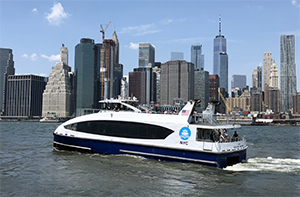Capt. James Arnpriester backed the ferry Owls Head away from New York City’s Pier 34 and pointed the bow east. He paused while a southbound city tanker passed, then throttled up the engines.
The catamaran quickly came to life. But within a minute, he pulled back on the controls and began the approach into Long Island City, Queens. The East River crossing took less than two minutes.
“They are really quick, which is nice,” Arnpriester said of the 86-foot, 149-passenger aluminum vessels now operating for NYC Ferry. “They are lightweight and these engines have plenty of torque, so they really do get up and go.”
The NYC Ferry service launched May 1, 2017, after two years of development. The city partnered with Hornblower Cruises to operate the network comprising 19 high-speed vessels. Six routes link every borough except Staten Island.
The East River run is by far the busiest of the NYC Ferry routes, accounting for nearly half of all riders. It starts at Pier 11 in Lower Manhattan and runs across the East River to stops in Brooklyn and Queens before returning to midtown Manhattan. The city ran a ferry along the route as a pilot before launching the new service.
Other NYC Ferry routes serve the Lower East Side of Manhattan, Rockaway and Astoria, Queens, South Brooklyn, and Soundview in the Bronx. Since launching, the ferry service has carried 6.5 million riders, and it’s projected to reach 9 million riders a year by 2023.
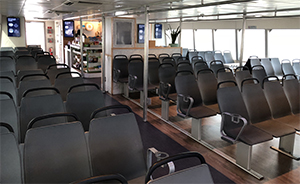 |
|
Amenities on the new fleet of vessels include airplane-style seating, an open second deck, bicycle storage and Wi-Fi. The ferries also have well-stocked bars and concession stands. |
On a sunny and warm day in July, the lower level on Owls Head was about half full, populated mostly by professionals staring at cellphones or reading books and newspapers. Seats were hard to come by on the exposed upper deck. People dressed for the office sipped coffee alongside tourists eagerly snapping photos of the Manhattan skyline.
Back in the wheelhouse, Arnpriester approached Greenpoint, the second stop on the return trip from the 34th Street Pier to Wall Street/Pier 11. Winds were calm as he aimed for the terminal extending 100 yards into the river. Pulling back on the throttles, he used the 2-knot facing current to ease into the landing.
Deck hand Mark Schmidt stood on the bow ready to open the loading ramp and check tickets. Schmidt signaled to the wheelhouse once everyone was on board. Arnpriester welcomed the new passengers and gave a safety briefing before getting underway. The entire process took just a few minutes.
“The bow-loading ferries are pretty much as efficient as you get. We are literally in and out,” Arnpriester said. “We push up, disembark the passengers, board the next crowd and then we’re pretty much off again.”
That’s precisely the idea. The city developed the NYC Ferry system to enhance its jam-packed public transit network. More than 5.5 million people ride the subways each day during the week, and the city’s bus network carries 2 million daily riders.
Ridership on the NYC Ferry vessels accounts for a tiny fraction of overall public transit use in New York, with between 12,500 and 15,000 passengers a day. But the ferries serve communities with limited access to other transit, and as several commentators in New York have noted, every little bit helps ease congestion on the subway. Each ride on the ferries costs $2.75, the same as the subway.
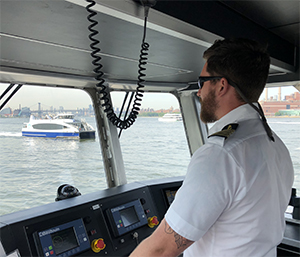 |
|
Capt. James Arnpriester guides Owls Head on the East River while another NYC Ferry boat speeds past. |
During one busy July weekend, Hornblower said 75,000 people rode its ferries — a significant jump in demand. At about the same time, the 350-passenger Ocean Queen Rockstar joined the NYC Ferry fleet. Hornblower now operates two 350-passenger boats and two more are expected by the end of 2018. An additional two are coming next year, all from Louisiana-based Metal Shark.
Metal Shark and Horizon Shipbuilding — now owned by Metal Shark after declaring bankruptcy — built all of the vessels in the NYC Ferry fleet, split across the 1,600-hp River class and the 2,800-hp Rockaway class. In addition to larger engines, the Rockaway-class boats have wider pontoons, a higher freeboard and a deeper draft. Incat Crowther of Australia provided the designs.
Propulsion aboard Owls Head and its River-class siblings comes from twin Baudouin 6M26.3 engines generating 803 hp each at 2,100 rpm. The engines turn five-blade Michigan Wheel props through ZF gearboxes. To improve stability, Humphree Interceptor trim tabs are installed at the transom. Service speed is 25 knots.
“The design is pretty great for the harbor here,” Arnpriester said. “They are pretty comfortable-riding boats.”
The trim tabs make the ride a little more pleasing for passengers while making a big difference with efficiency. “Trimming the boat down properly is going to mean we’re burning less fuel at the same speed, so they help us overall,” he said.
NYC Ferry captains typically work eight-hour shifts, although sometimes they stay at the controls for a little longer. Although the routes themselves don’t change, conditions in the harbor are always fluid. The East River in particular is extremely busy with ferries, tugboats, personal watercraft and even swimmers. The occasional large ship also passes through.
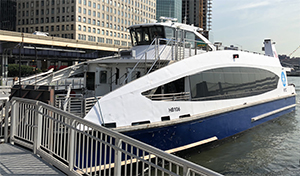 |
|
HB106 awaits passengers at Wall Street/Pier 11 in Lower Manhattan. Ferries in the new fleet arrive bow-first at each terminal for faster loading and unloading. |
Managing currents is another focus given the varied approaches to the terminals. Some of the approaches allow ferries to come straight into the landing, while others require tight turns either with or against the tidal flow.
“(This landing) right here, and the next one we go to, we are perpendicular to the current,” Arnpriester said as Owls Head approached the terminal at North Williamsburg. “You have to know exactly what the current is doing before you get there.”
Arnpriester, who grew up in Massachusetts and still has the accent, has been with NYC Ferry since before the service launched. He traveled to the Gulf of Mexico to deliver four of the early newbuilds to New York. The vessels stayed outside the Intracoastal Waterway for much of the journey, offering a glimpse of their capabilities in rougher water.
“Obviously, you have limitations with an 86-foot aluminum boat, but they did great,” Arnpriester said. “It was actually a pretty rough spring in the Gulf of Mexico, and all things considered they did really well. They ran into probably more than anything we’ll ever see in the harbor. They are definitely well built.”
Hornblower has more than 325 people working for NYC Ferry, including dozens of captains and deck hands. Fifty engineers work all hours at the Brooklyn Navy Yard to keep the vessels running safely and efficiently. Brendan Smith and Dominic Rinaldi, the director of engineering and engineering manager, respectively, oversee that operation.
Both men joined Hornblower in New York after Navy careers working on nuclear submarines. The two have tried to instill a similar level of discipline in the maintenance, repair and safety regimen across the ferry fleet. By now, they said, any issues require only tweaks rather than major fixes, but they’re always looking for improvement.
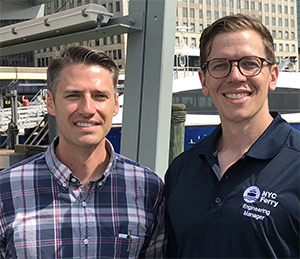 |
|
Brendan Smith, left, director of engineering for NYC Ferry, and Dominic Rinaldi, the engineering manager, have developed maintenance and repair systems aimed at maximum efficiency. |
“The main thing we do in our department is constantly reassessing processes and systems and making sure everything is more efficient every day we operate,” Smith said.
One benefit of starting the service from scratch, Rinaldi said, is the ability to establish best practices right from the start. “Our standards are very, very high,” he said. “The benefit of our backgrounds is we don’t have the industry norms in mind when we do what we do. And that is a benefit rather than a detriment.”
Back on board Owls Head, Arnpriester steered the vessel along the Brooklyn waterfront. Marquise Steele ran the well-stocked concession stand, and deck hand Syed Hoque kept watch of the passenger spaces. Hoque is a SUNY Maritime graduate who has since been promoted to captain.
“I like the variety. I’m always doing different routes, so I get to see a lot of the city most people don’t get to see,” Hoque said, noting that he’d yet to work through a New York City winter.
Arnpriester steered Owls Head under the Brooklyn Bridge for a quick stop in the Dumbo section of Brooklyn. Minutes later, the vessel sped due west across the East River toward its final stop at Pier 11.
During rush hour, it’s common to see five or six ferries coming and going from Pier 11 at once, many loaded with commuters from New Jersey, making for a tricky approach. But during this trip, most workers were already at their desks and river traffic was tame. Arnpriester turned to port and guided the vessel softly into position.
Wall Street/Pier 11 is the end of the line, but a dozen or so people were waiting to climb on board for another run. For the crew, it was just another stop in a day spent helping New Yorkers get where they’re going.

